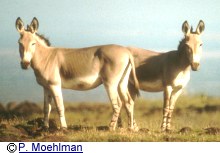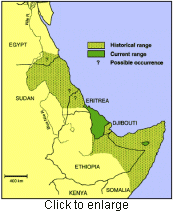African Wild Ass
Equus africanus
CR
 Taxonomic Authority: Heuglin & Fitzinger, 1866
Taxonomic Authority: Heuglin & Fitzinger, 1866
Synonyms and Common names:
Somalicus P.L. Sclater, 1885
African Wild Ass - English (Primary)
Adghi Bareka (Tigrinia) - Undetermined
African Ass - English
Ane Sauvage D'Afrique - French
Asno Salvaje De Africa Spanish - Castilian
Dibakoli (Afar, Ethiopia) - Afar
Dibokoli (Afar, Eritrea) - Afar
Gumburi - Somali
This taxon is sometimes treated under the specific name asinus. However, this is considered to be the name applied to the domestic form and is so generally rejected in favour of africanus. Gentry (2006) criticized the incorrect use of the name E. asinus for the wild ass by Grubb (2005). There are two recognized extant subspecies, although there is disagreement as to whether the African Wild Ass is one continuously distributed species exhibiting clinal variation (see Moehlman 2002; Moehlman et al. in press). Groves (2002) lists a third unnamed subspecies from the Sahara, although these may not have been true wild asses.
General Information
Distribution

The African Wild Ass occurs in Eritrea, Ethiopia, and Somalia; some animals may persist in Djibouti, Sudan and Egypt, but there is
no recent information available (Moehlman et al. in press). Yalden et al. (1996) recorded them to 1500m in Ethiopia.
Two subspecies are recognized. The Nubian Wild Ass, E. a. africanus, lived in the Nubian desert of north-eastern Sudan, from east of the Nile River to the shores of the Red Sea, and south to the Atbara River and into northern Eritrea. During aerial flights in the 1970s, wild asses were seen in the Barka Valley of Eritrea and in the border area between Eritrea and the Sudan. The Somali Wild Ass, E. a. somaliensis, was found in the Denkelia region of Eritrea, the Danakil Desert and the Awash River Valley in the Afar region of north-eastern Ethiopia, western Djibouti, and into the Ogaden region of eastern Ethiopia. In Somalia, they ranged from Meit and Erigavo in the north to the Nugaal Valley, and as far south as the Shebele River (Moehlman 2002; Moehlman et al. in press).
The current range of the African Wild Ass (in Ethiopia and Eritrea) is approximately 15,000 km2. DNA extracted from faecal samples collected from animals in Eritrea and Ethiopia resulted in the identification of five mitochondrial DNA haplotypes: one haplotype (group of polymorphisms) specific to the Eritrean population (haplotype D); one haplotype specific to the Ethiopian population (E); and three shared haplotypes (A, B, and C). These results suggest that there is and/or has been gene flow between the subpopulations (Afrera, Serdo) in Ethiopia and the population in Eritrea (Oakenfull et al. 2002).
Population
In Ethiopia, there has been a severe population decline since the early 1970s. Klingel (1972) recorded group sizes of 10-30
individuals in the Danakil, and he estimated a density of 18.6 wild asses per 100 km2 in an area of approximately 10,000 km2.
During that survey, Yangudi-Rassa National Park had the highest density (30 wild asses per 100 km2). In 1994, Moehlman and
Kebede did a ground survey of the Yangudi-Rassa N.P.; no wild asses were seen, although local Issa pastoralists reported that
they were present but rare and occurred at an approximate density well below one animal per 100 km2 (Moehlman 1994; Kebede
1995; Moehlman et al. 1998). In 2007, Kebede (F. Kebede et al. pers. comm. 2007) surveyed the historic range of the African Wild
Ass in Ethiopia and determined that they have been extirpated from the Yangudi-Rassa N.P. and the Somali Region and that the
only remaining population is in the north-eastern Afar Region. The total number of wild ass observed during this survey was 25
in an area of 4000 km2 yielding a density of 0.625 animals per 100 km2. This density is higher than that of 1994-1998 survey, which
was 0.5 wild ass per 100 km2 in an area of 2000 km2 (Moehlman 2002). In the Serdo-Hillu area, where there has been a research
and conservation programme with Ethiopian Wildlife Conservation Authority and local Afar pastoralists for the past ten years, the
population has remained stable. Although the number of African Wild Ass in this area has not declined, the population is very
small and under high risk of extinction. There may be fewer than 200 African Wild Ass left in Ethiopia.
In Eritrea, there are limited long-term data. The first successful survey was made in 1996 and there has been a research and conservation programme with the Ministry of Agriculture for the past ten years. The main study site in the Northern Red Sea Zone has had a population of roughly 47 individuals per 100 km2 (Moehlman et al. 1998; Moehlman 2002). This is the highest population density found anywhere in the present range of the species and is similar to population densities recorded in Ethiopia in the early 1970s. This is a limited study area (100 km2), but recent research indicates that African Wild Ass currently inhabit approximately 11,000 km2 in the Denkeli desert (Teclai 2006). Surveys are needed to determine the distribution and density of African Wild Ass in this larger area. A rough estimate of African Wild Ass in Eritrea would yield a total of possibly 400 individuals.
In Somalia, in 1997, local pastoralists said that there were less than 10 African Wild Ass left in the Nugaal Valley; an earlier ground survey in 1989 in the Nugaal Valley yielded population estimates of roughly 135-205 animals or approximately 2.7-4.1/km2 (Moehlman 1998). Some animals may remain near Meit and Erigavo, but this area has not been surveyed since the 1970s (Moehlman et al. in press). It is not known if African Wild Ass currently persist in Somalia.
In summary, the total number of observed African Wild Ass in Eritrea and Ethiopia is 70 individuals; there may be as many as 600 individuals in these two countries, but this figure is a very rough extrapolation from more intensely studied areas. The number of mature individuals is approximately one-third of the population (Feh et al. 2001), hence the minimum number of mature individuals is 23 and the maximum might be 200. In Ethiopia, in the last 35 years there has been a greater that 95% population decline and in the last 12 years the African Wild Ass has been extirpated from roughly 50% of its range (Kebede et al. 2007). In Eritrea, the population is stable and slowly increasing. However, it is difficult to predict population trends into the future. The desert habitat of the African Wild Ass in both Eritrea and Ethiopia suffers from recurrent and extreme droughts (Kebede 1999;
Habitat and Ecology
The primary habitat is arid and semi-arid bushland and grassland. In Eritrea and Ethiopia, the African Wild Ass lives in volcanic
landscape of the Great Rift Valley where they range from below sea level in the Dalool Depression to 2,000m asl (Moehlman et al.
in press).
In Eritrea and Ethiopia, limited observations indicate that African Wild Asses are primarily grazers, but that they will also utilize browse. Typical of arid habitat equids, the only stable groups are composed of a female and her offspring. Females do associate with other females or with males, but even temporary groups are small. Low density and low sociability may be due to low forage quality and availability. In the Mille-Serdo Wild Ass Reserve the preferred forage is Aristida sp, Chrysopogon plumulosus, Dactyloctenium schindicum, Digiteria sp, Lasiurus scindicus, and Sporobolus iocladus (Kebede 1999; Moehlman 2002; Moehlman et al. in press). In Eritrea, Pannicum turgidium is an important forage species (Teclai 2006).
Threats
The major threat to the African Wild Ass is hunting for food and medicinal purposes; for example, body parts and soup made
from bones are used for treating tuberculosis, constipation, rheumatism, backache, and boneache (Kebede 1999; Moehlman 2002;
Moehlman et al. in press). Limited access to drinking water and forage (largely due to competition with livestock) is also a major
constraint, with reproductive females and foals less than three-months old most at risk. Hence, it will continue to be important to
determine critical water supplies and basic forage requirements, allowing management authorities to determine (in consultation
with local pastoralists) how to conserve the African Wild Ass (Kebede 1999, 2007; Moehlman 2002; Teclai 2006; Moehlman et al. in
press). The third major threat to the survival of the African Wild Ass is possible interbreeding with the domestic donkey
(Moehlman 2002; Moehlman et al. in press).
Conservation Measures
Listed on CITES Appendix I. In Ethiopia, the Yangudi-Rassa National Park (4,731 km2) and the Mille-Serdo Wild Ass Reserve
(8,766 km2) were established in 1969. However, the former has never been formally gazetted, and both areas are utilized by large
numbers of pastoralists and their livestock. These areas are remote and extremely arid, and the Ethiopian Wildlife Conservation
Organization (EWCO) has not had sufficient funds or personnel for appropriate
management (Kebede 1999). In Eritrea, the government designated the African wild ass area between the Buri Peninsula and the
Dalool Depression as a high-priority area for conservation protection as a nature reserve. In both Eritrea and Ethiopia, research
and conservation programmes (Ministry of Agriculture and EWCA) have been critical for sustaining African Wild Ass populations
by involving local pastoralists in their conservation. There are no protected areas in the range of the species in Somalia.
Populations of Somali Wild Ass are maintained in captivity (Moehlman 2002).
Recommended research and conservation actions, include:
1. Ecosystems based and population dynamics research on the African Wild Ass in Eritrea and Ethiopia.
2. Research on interactions among pastoralists, livestock, wildlife and the environment
3. Actively involve local pastoralists in the preparation and management of long-term action plans
4. Post-graduate training of personnel in Eritrea and Ethiopia.
5. Surveys in Eritrea, Djibouti, Sudan and Egypt to determine current distribution of African wild ass
6. Genetic research on the African Wild Ass and local domestic donkey populations to clarify the genetic status of the two
Subspecies.
IUCN Red Listing
Red List Assessment: Using 2001 IUCN Critically Endangered (CR)
Red List Criteria: C2a(i)
Rationale for the Red List Assessment
Listed as Critically Endangered as the species numbers at best approximately 200 mature invidivuals, may be undergoing a
continuing decline due to climate and human/livestock impact, and no subpopulation numbers in excess of 50 mature individuals.
The species may also meet the threshold for Critically Endangered under D, as there may be less than 50 mature individuals in the
wild.
Current Population Trend: Decreasing (Date of Assessment: 2008)
Name(s) of the Assessor(s): Moehlman, P., Yohannes, H., Teclai, R. and Kebede, F.
Evaluator(s): Rubenstein, D., Hack, M. and Hrabar, H.
Bibliography
Gentry, A., 2006, Mammal Species of the World. A taxonomic and geographic reference. 2005. D.E. Wilson & D.M. Reeder (Eds.), Ed. 3, 2 vols., 2142 pp. Johns Hopkins University Press, Baltimore. ISBN 0-8018-8221-4. A nomenclatural review., Bulletin of Zoological Nomenclature3, 215-219, ,
Groves, C.P., 2002, Taxonomy of the Living Equidae, Equids: Zebras, Asses and Horses. Status Survey and Conservation Action Plan, Patricia D. Moehlman, 108-112, IUCN, Gland
Grubb, P., 2005, Order Perissodactyla, Mammal Species of the World, D.E. Wilson;D.M. Reeder, 629-636, The Johns Hopkins University Press, Baltimore
Kebede, F., 1999, Ecology and conservation of the African wild ass (Equus africanus) in the Danakil, Ethiopia, , M.Sc. thesis, University of Kent, Canterbury, UK
Kebede, F., Berhanu, L. and Moehlman, P. D., 2007, Distribution and Population Status of the African Wild Ass (Equus africanus) in Ethiopia. Report to Saint Louis Zoo., , ,
Klingel, H., 1977, Observations on social organization and behavior of African and Asiatic wild asses (Equus africanus and E. hemionus), Z. Tierpsychol.44, 323-331, ,
Moehlman, P.D., 1998, Feral Asses (Equus africanus): Intraspecific variation in social organization in arid and mesic habitats, Applied Animal Behavior Science, 171-195, ,
Moehlman, P.D., 2002, Status and action plan for the African wild ass (Equus africanus), Equids: Zebras, Asses and Horses. Status Survey and Conservation Action Plan, Patricia D. Moehlman, 2-10, IUCN, Gland
Moehlman, P.D., Kebede, F. and Yohannes, H., 1998, The African wild ass (Equus africanus): Conservation status in the Horn of Africa, Applied Animal Behavior Science60(2,3), 115-124, ,
Moehlman, P.D., Kebede, F. and Yohannes, H., in press, Equus africanus, The Mammals of Africa. Volume 5. Carnivores, Pangolins, Rhinos and Equids, Kingdon, J.S. and Hoffmann, M., , Academic Press, Amsterdam
Oakenfull, A., Yohannes, H., Kebede, F., Swinburne, J., Binns, M. and Moehlman, P.D., 2002, Conservation Genetics of African Wild Asses. Final report for the Zoological Societies of Chicago and San Diego. November 2002, , ,
Teclai, R., 2006, Conservation of the African wild Ass (Equus africanus) on Messir Plateau (Asa-ila), Eritrea: The role of forage availability and diurnal activity pattern during the wet season and beginning of the dry season. MSc thesis, University of Kent., , ,
Yalden, D.W., Largen, M.J., Kock, D. and Hillman, J.C., 1996, Catalogue of the mammals of Ethiopia and Eritrea. 7. Revised checklist, zoogeography and conservation., Tropical Zoology9, 73-164, ,



